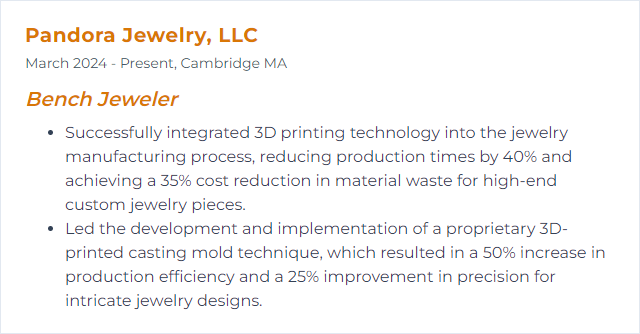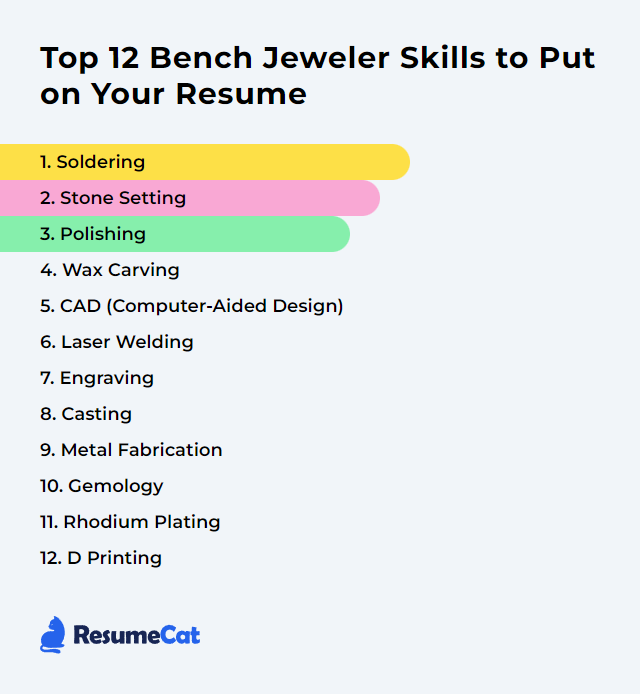Top 12 Bench Jeweler Skills to Put on Your Resume
Crafting a standout resume as a bench jeweler means spotlighting that uncommon pairing: firm-handed technical control and a keen eye for beauty. Put your specialized strengths front and center. Precision. Finish. Fit. Each detail whispers skill—and in a crowded market, that whisper carries.
Bench Jeweler Skills
- Soldering
- Stone Setting
- Polishing
- Wax Carving
- CAD (Computer-Aided Design)
- Laser Welding
- Engraving
- Casting
- Metal Fabrication
- Gemology
- Rhodium Plating
- 3D Printing
1. Soldering
In jewelry work, soldering joins metal parts using a lower-melting-point filler that flows precisely where heat coaxes it. Clean seams, strong joints, minimal distortion—done right, it’s invisible strength.
Why It's Important
Solid, tidy joins keep designs intact through wear and time. Soldering is the backbone of assembly, resizing, repair, and refinement.
How to Improve Soldering Skills
Right tools, tuned well: Torch with good control, matched solders (hard/medium/easy), reliable flux, third hands, heat sinks.
Obsess over cleanliness: Degrease, de-ox, fit tight. Any grime or gap invites failure.
Flux with intent: Coat contact zones so the metal stays active and the solder runs clean.
Heat the work, not the stick: Even, progressive heat so solder chases the hot zone, not a random puddle.
Sequence smartly: Hard first, then medium, then easy to protect earlier joints.
Practice across metals: Silver, gold alloys, platinum—they behave differently. Learn their quirks.
Trade notes with peers: Workshops, shop talks, and communities such as Ganoksin sharpen technique.
Consistency arrives slowly, then all at once. Keep at it.
How to Display Soldering Skills on Your Resume
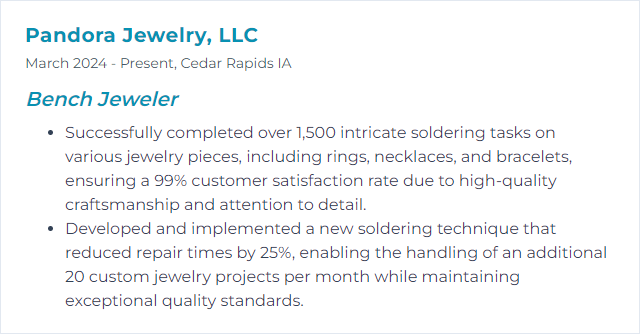
2. Stone Setting
Stone setting secures gems into metal in ways that highlight fire, color, and symmetry while protecting edges and girdles. Prong, bezel, channel, pavé, tension—each has a voice.
Why It's Important
Security meets brilliance. A customer sees sparkle; you make sure it survives real life.
How to Improve Stone Setting Skills
Repetition with variety: Practice every style on different alloys and stone cuts. Muscle memory matters.
Tool tune-ups: Sharp gravers, polished burnishers, properly profiled beading tools. Sloppy edges create sloppy seats.
Know your materials: Mohs hardness, cleavage, treatments, brittleness. Adjust pressure and approach to the stone, not the other way around.
Start simple, scale up: Nail bezels and classic prongs before pavé grids and channels.
Measure twice, seat once: Even bearing cuts and true level seats prevent rocking and chipping.
Seek critique: Mentors, forums, shop mates. Fresh eyes catch the tilt you missed.
Stay current: Trends shift; techniques refine. Interweave Jewelry and professional communities report what’s moving.
How to Display Stone Setting Skills on Your Resume

3. Polishing
Polishing removes tool marks and micro-scratches, stepping through abrasives to a crisp, radiant finish. The last mile makes the piece.
Why It's Important
Finish sells. Surface quality reveals craftsmanship and hides nothing.
How to Improve Polishing Skills
Match media to metal: Different compounds and mops for silver, gold, platinum, palladium. Hardness dictates the stack.
Stage your grits: Coarse to cut, medium to refine, fine to shine—don’t skip steps.
Keep wheels clean: Cross-contamination grinds scratches right back in.
Controlled pressure and motion: Keep it moving; avoid edges catching and heat build-up.
Ventilate and protect: Eye protection, masks, dust collection. Health is a tool too.
Want more ideas? Ganoksin, Rio Grande education articles, and Jewelry Making Journal share pragmatic, field-tested finishing advice.
How to Display Polishing Skills on Your Resume
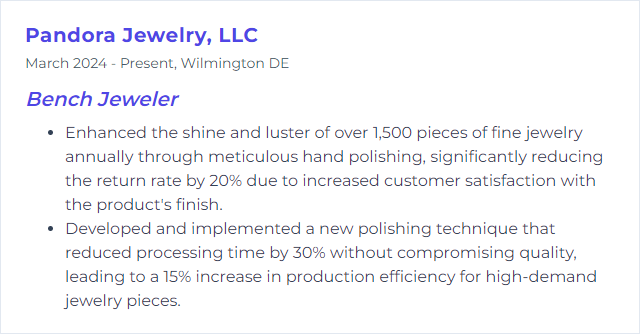
4. Wax Carving
Wax carving builds form in a forgiving medium, then hands it to metal via lost-wax casting. Grooves, textures, undercuts—ideas get sculpted before they’re forever.
Why It's Important
It unlocks shapes that are slow or impossible to fabricate directly. Custom design thrives here.
How to Improve Wax Carving Skills
Know your waxes: Blue for crisp detail, green for carving strength, purple blends—each responds differently to heat and blade.
Sharp, varied tools: Micro chisels, saws, files, heated tools, burs. Maintain edges obsessively.
Accurate layout: Clean design transfer and scribed centerlines keep symmetry honest.
Build textures deliberately: Practice textures that cast cleanly; test and adjust.
Pre-cast discipline: Smooth, repair, and vent the model to cut down on casting flaws.
Study the casting chain: Understanding burnout and investment informs what you carve—and what you avoid.
Keep learning: Courses and workshops through community studios, Jewellers Academy, and similar groups help level-up fast.
How to Display Wax Carving Skills on Your Resume
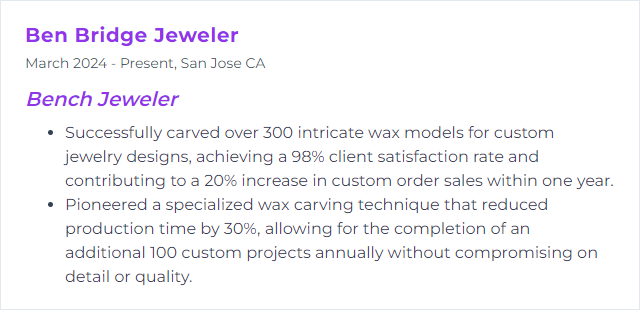
5. CAD (Computer-Aided Design)
CAD lets you prototype in pixels: iterate quickly, validate proportions, and hand off precise files for printing or milling. Think faster, change faster, reduce guesswork.
Why It's Important
Accuracy, repeatability, and visualization—designs get clearer and production gets cleaner.
How to Improve CAD (Computer-Aided Design) Skills
Foundations first: Learn core modeling concepts—curves, surfaces, solids, tolerances—before chasing plugins.
Daily practice: Model a ring a day for a month. Vary settings and constraints.
Use jewelry-focused tools: Rhino, MatrixGold, and 3Design streamline common tasks like stones, galleries, and prongs.
Study manufacturability: Design for the process you’ll use—casting, milling, printing—so walls, prongs, and tolerances survive reality.
Solicit feedback: Share files with peers for critique. Small tweaks compound into major gains.
Stay updated: Follow release notes and community threads; new features often solve old headaches.
How to Display CAD (Computer-Aided Design) Skills on Your Resume
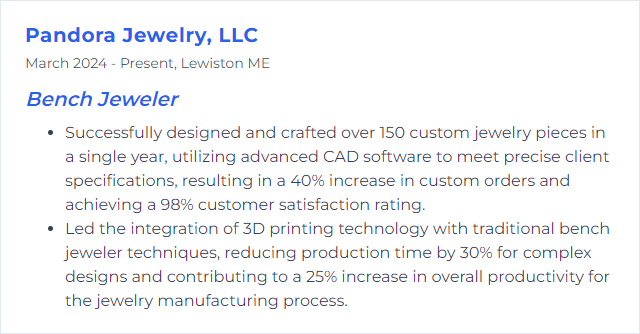
6. Laser Welding
Laser welding pinpoints heat to fuse or build metal with microscopic control. Claws next to stones, porosity fixes, hairline seams—handled without torch sprawl.
Why It's Important
Precision without collateral damage. Repairs and builds that would be risky or impossible with flame become routine.
How to Improve Laser Welding Skills
Formal training pays: Learn how pulse width, energy, and spot size interact across alloys.
Prep like a pro: Clean, align, and fixture the part. Magnification is your friend.
Dial in parameters: Test coupons first. Adjust power, frequency, and focus until the bead wets cleanly.
Pulse shaping matters: Tailored pulse profiles reduce cracking and undercut, especially on brittle alloys.
Assist gas when needed: Argon shields can improve color and reduce oxidation.
Maintain the optics: Lenses and mirrors get dirty; performance drops fast if you neglect them.
Routine calibration: Keep the machine within spec; reliability follows.
How to Display Laser Welding Skills on Your Resume

7. Engraving
Engraving cuts designs into metal—lettering, scrolls, flourishes—by hand or assisted tools. Detail work that adds voice and meaning.
Why It's Important
Personalization and artistry in one move. The smallest cuts can define a piece.
How to Improve Engraving Skills
Daily line control: Straight lines, curves, consistent depth. Repetition builds steadiness.
Tool geometry: Grind gravers correctly and polish heels; the cut changes dramatically with small angles.
Ergonomics and vision: Steady posture, bright lighting, proper magnification.
Material awareness: Softer metals smear; harder ones chip. Alter speed and pressure accordingly.
Blend tech where useful: Laser guides and CAD layouts help with spacing and repeatability.
Learn from specialists: Master engravers, local classes, and communities like Ganoksin or The Engraver’s Cafe accelerate progress.
How to Display Engraving Skills on Your Resume
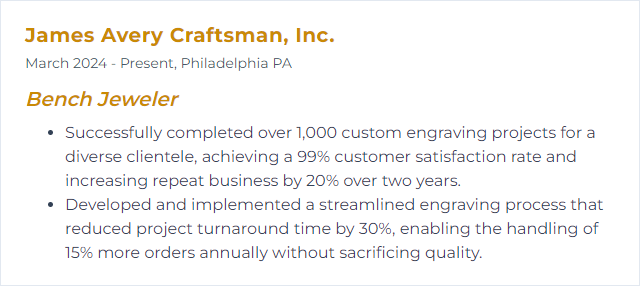
8. Casting
Casting turns wax or printed patterns into metal through investment, burnout, and pour. Intricate geometries become achievable and repeatable.
Why It's Important
It enables complexity and scale while keeping detail sharp—great for custom and small-batch runs.
How to Improve Casting Skills
Flawless patterns: Perfect the wax or print. Every bump shows up in metal.
Investment discipline: Precise ratios, vacuum de-airing, and consistent set times reduce surface defects.
Controlled burnout: Follow ramp schedules suited to the resin or wax used to prevent ash and cracking.
Right temperature, right moment: Pour at the sweet spot for the alloy; avoid turbulence.
Choose your method: Centrifugal vs. vacuum casting—match technique to part geometry.
Track variables: Record each run (temps, times, alloys). Patterns emerge; yields improve.
Learn with peers: SNAG workshops and professional communities share process tweaks worth gold.
How to Display Casting Skills on Your Resume
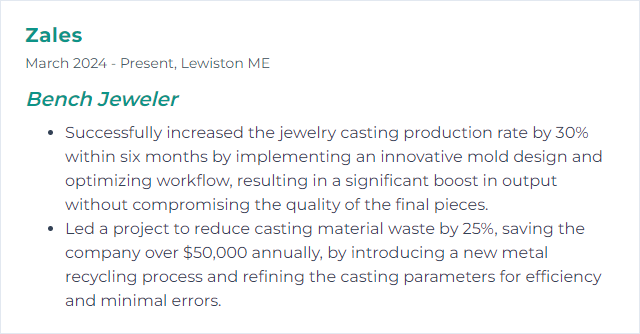
9. Metal Fabrication
Cutting, forming, soldering, forging—fabrication turns sheet and wire into structure. It’s problem-solving with pliers and fire.
Why It's Important
Custom builds, repairs, one-off solutions—fabrication fills the gaps casting can’t reach.
How to Improve Metal Fabrication Skills
Invest in precision: Quality saws, stakes, hammers, micro-motors, and measuring tools pay back in accuracy.
Plan the sequence: Anneal, form, solder, true, and finish in an order that preserves earlier steps.
CAD as a companion: Use CAD to test proportions and clearances before cutting metal.
Lean workflow: Reduce rework and motion. Organized benches produce cleaner outcomes.
Quality control gates: Check fit and straightness at each stage. Catch errors while fixes are cheap.
How to Display Metal Fabrication Skills on Your Resume
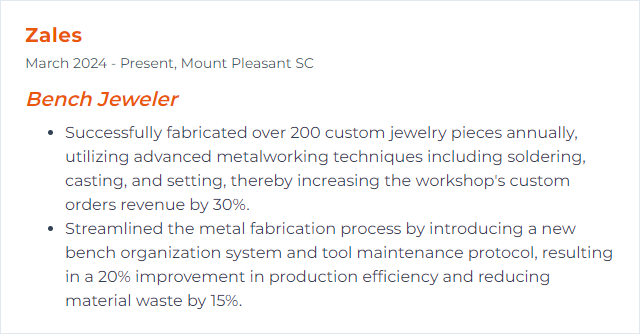
10. Gemology
Gemology examines identity, quality, and treatments—what the stone is, where it stands on the scale of value, and how to handle it safely.
Why It's Important
Correct identification and ethical knowledge protect both the piece and the client’s trust.
How to Improve Gemology Skills
Formal study: Reputable programs (GIA and others) deepen grading, optics, and treatments knowledge.
Hands-on practice: Work with loupes, microscopes, refractometers, and spectroscopes routinely.
Sample widely: Examine natural, treated, and synthetic stones. Contrast sharpens judgment.
Network smart: Join associations and attend shows to stay on top of market shifts and new treatments.
Prioritize ethics: Track sourcing, disclosures, and sustainability considerations. Transparency matters.
How to Display Gemology Skills on Your Resume
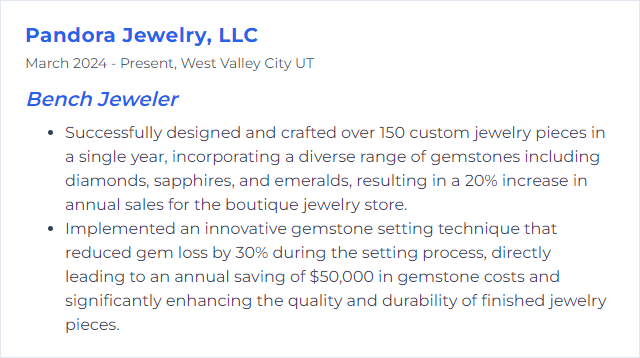
11. Rhodium Plating
Rhodium plating lays down a bright, protective layer—especially on white gold—to boost whiteness, resist scratches, and slow tarnish.
Why It's Important
It’s the difference between “nice” and “mirror bright,” with durability to match.
How to Improve Rhodium Plating Skills
Prep like a finisher: Ultrasonic, steam, electroclean. Any residue ruins adhesion.
Healthy bath, healthy results: Monitor pH, temperature, and contamination. Filter regularly.
Dialed-in parameters: Lower voltage with longer time often yields smoother coats—test and document.
Rinse deliberately: Distilled water between steps to prevent drag-in and spotting.
Safety and maintenance: Gloves, eye protection, good ventilation, and well-maintained anodes and leads.
Suppliers and communities such as Rio Grande and Ganoksin publish dependable process notes and troubleshooting charts.
How to Display Rhodium Plating Skills on Your Resume
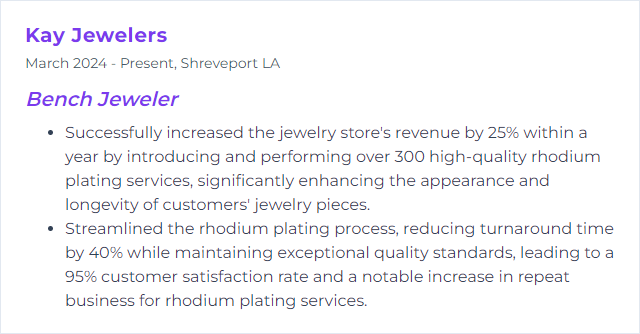
12. 3D Printing
3D printing turns CAD files into physical patterns or parts layer by layer—usually in castable resins for jewelry—shrinking lead times and enabling intricate geometry.
Why It's Important
Rapid prototyping, repeatability, and fine detail with fewer manual bottlenecks.
How to Improve 3D Printing Skills
Use high-resolution machines: Aim for 25 microns or finer when detail is king; brands like Formlabs excel here.
Choose the right resin: Castable resins designed for clean burnout reduce ash and improve fill.
Orient with intention: Support placement, angle, and wall thickness affect surface quality and print time.
Post-process properly: Thorough IPA wash and UV cure to lock in detail and dimensional stability.
Close the loop: Compare prints to finished casts; adjust CAD and print parameters based on results.
Keep learning: Industry outlets like B9Creations and 3D printing forums share resin profiles, settings, and fixes.
How to Display 3D Printing Skills on Your Resume
